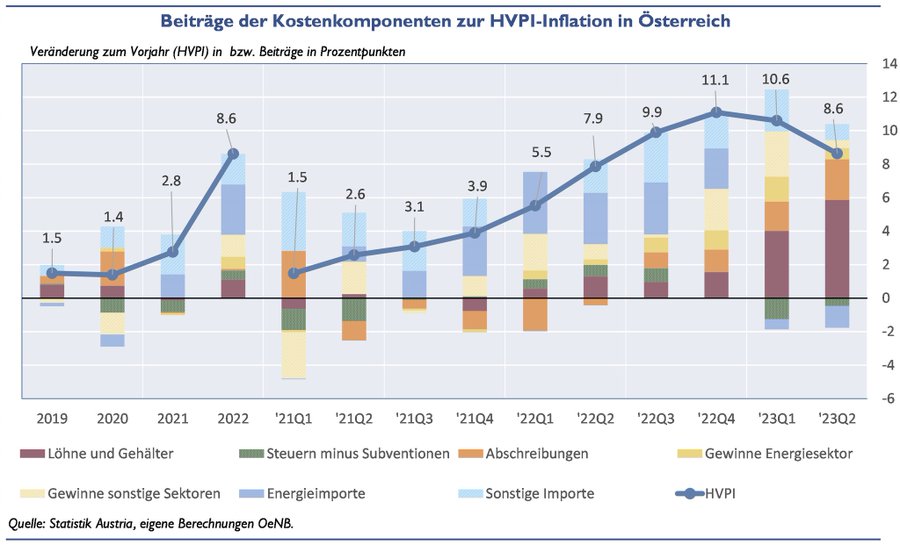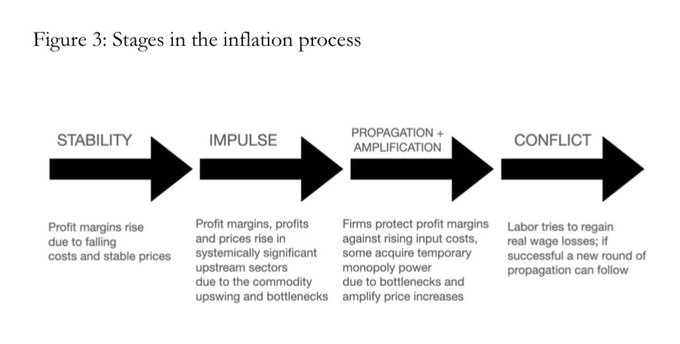Inflation: The Austrian Central Bank sees it as a series of waves in a pond

Inflation in Austria has become the subject of lively discussion recently. The significant increase in energy import prices is unquestionably a trigger. However, differences of opinion arise over the extent to which inflation was also fueled by corporate profits and wage increases. To try to answer this question, the Austrian Central Bank has developed a new approach to how inflation develops which is quite interesting. According to this vision, inflation develops in successive waves after an initial imbalance, like waves that follow one another in a pond after throwing a stone.
The Role of Imports and Corporate Profits
Our results indicate that the increase in inflation, observed since mid-2021, was mainly triggered by a significant increase in import prices, especially for energy and manufactured goods. However, from mid-2022 onwards, we are increasingly seeing second-round effects: rising corporate profits have intensified price increases, initially in the energy sector and subsequently in other sectors of the economy. Furthermore, from the beginning of 2022/23, further second-round effects have manifested themselves in the form of larger salary increases. In the second quarter of 2023, it was wages, or more precisely unit labor costs, that were the main driver of inflation. This trend is expected to persist until the end of 2024, with wages continuing to play a leading role in rising prices. Here is a graph that indicates how the individual inflation components have developed over time:
As can be seen, there are successive phases in the development of inflation: a bit like throwing a stone generates more concentric waves, in the same way the initial imbalance in prices, linked to external factors, causes other waves, first, through the increase in profits, therefore with the increase in remuneration, which must be rebalanced after the inflation phenomenon. Here is a graph that further explains this trend, giving a different definition to the various phases, so let's move on to considering them individually
The Impact of Imports on Inflationary Trends
2021 saw an increase in inflation in Austria mainly due to imports. In addition to price increases caused by disruptions in the international supply chain due to the pandemic, energy imports have started to drive inflation since the end of 2021. In 2022, Austrian inflation rose to 8.6%, with over a third attributable to energy imports and another quarter to other imports. In the first half of 2023, the contribution to inflation of imports began to decline, but only imports of food and processed products continued to exert significant inflationary pressures. Energy imports, on the other hand, had a slightly dampening effect on inflation during the same period.
The Key Role of Corporate Profits
Over the course of 2022, rising corporate profits further contributed to price pressure. The energy sector was mainly responsible for this dynamic. Corporate profits in this sector followed the increase in wholesale energy prices with a lag of one year, due to long-term contracts in the energy sector. As a result, price increases were gradually passed on to consumers. In the fourth quarter of 2022 and the first quarter of 2023, significant earnings increases were reported in other sectors, including restaurants and hospitality, financial services and insurance. On average, corporate profits accounted for just under a quarter of annual inflation in 2022, but this share increased in the second half of the year. In the first quarter of 2023, the contribution of earnings to inflation peaked at 40%, but declined sharply in the second quarter of 2023 due to the economic situation.
The Dominant Role of Wages
In 2022, wage prices did not exert significant pressure on prices, due to the delay in wage negotiations typical for Austria. Unit labor costs contributed only 13% of inflation. However, in the first half of 2023, collective agreements concluded with more favorable conditions than in the euro area resulted in a significant increase in the wage contribution to inflation, which was 38% in the first quarter. In the second quarter, wages were the main driver of inflation, contributing more than two-thirds of the price increase. This phase is defined as "Conflictual" due to the presence of social conflicts in the definition of the new balance.
Other Factors to Consider
Other factors that influenced inflation include public aid measures, such as the VAT reduction for restaurants, hotels and culture, which had a significant impact in 2022. However, reductions in energy-related levies were not enough to offset this upward price push in the first three quarters of 2022. Rising electricity prices only started to curb inflation starting in December 2022.
Future perspectives
Regarding the future outlook, according to this theory it can be expected that wages will continue to play a significant role in inflation until 2024, mainly due to the delay in the wage adjustment process in Austria. Furthermore, the current labor shortage could push many companies to maintain employment levels despite the weak economic situation, further increasing unit labor costs. A similar process is visible in other European countries, including Italy.
At the same time, replacement investments needed to maintain capital will continue to rise in price due to high inflation, putting further pressure on corporate profits. However, the extent of future inflation will depend crucially on second-round effects. An excessive weight in corporate earnings developments will cause a significant social push for a wage increase. Therefore the containment action of the second phase becomes important if the effect of the third is to be contained.

Thanks to our Telegram channel you can stay updated on the publication of new Economic Scenarios articles.
The article Inflation: the Austrian Central Bank sees it as a series of waves in a pond comes from Economic Scenarios .
This is a machine translation of a post published on Scenari Economici at the URL https://scenarieconomici.it/inflazione-la-banca-centrale-austriaca-la-vede-come-una-serie-di-onde-in-uno-stagno/ on Sun, 01 Oct 2023 05:30:39 +0000.


